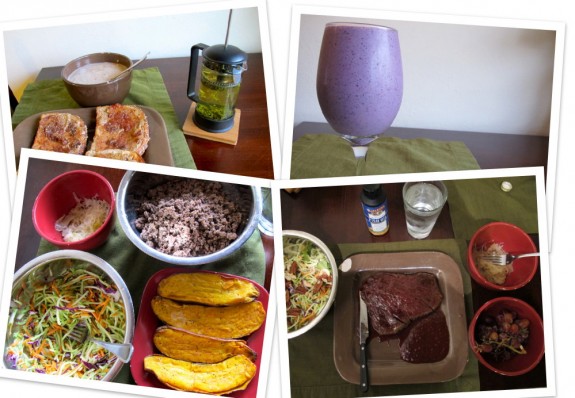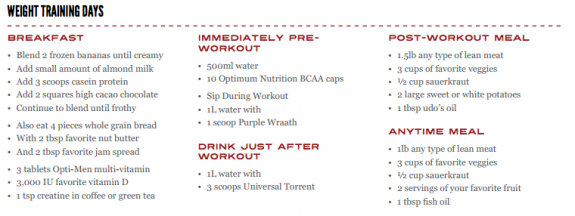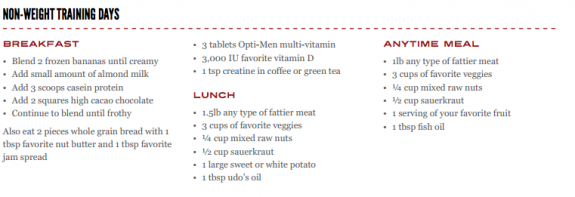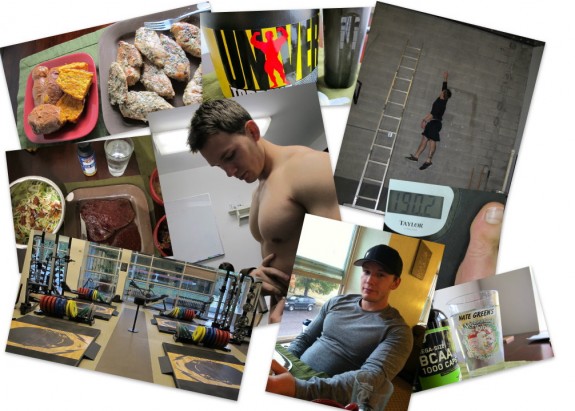What I Learned: 5 Lessons From My Crazy Weight-Manipulation Experiment
I gained 20 pounds in 28 days, lost 20 pounds in 5 days, and gained it all back in 24 hours. Here are my top 5 strategies to help you do a less insane version of my experiment.
I recently spent 34 days drastically manipulating my body and learning the secrets to rapid weight gain, insanely quick weight loss, and mental toughness. I even wrote a book about the entire process and gave it away for free.
Well today I’m proud to announce the free PDF download of BIGGER, smaller, BIGGER. (Click the link, visit the site, and download the beautifully-designed e-book.)
To celebrate the release, I’m sharing the top 5 workout, nutrition, and lifestyle strategies I used during the experiment. Try them out for yourself and use them to build more muscle, get healthier, and become your own hero.
5 Lessons From My Crazy Experiment
1. Eat the same meals over and over
When you’re trying to gain muscle fast, you want things to be as simple and boring as possible. Choice is the enemy; routine is your friend.
Too many choices equals too much mental energy and no action. That’s why I ate the same meals over and over for the entire 28-day weight-gain portion of the experiment.
Here was a typical day of eating during that phase:
Breakfast
- 2 frozen bananas, blended until creamy
- Small amount of almond milk
- 3 scoops of casein protein
- 2 squares of dark chocolate
- 4 pieces of whole grain bread
- 2 tbsp almond butter
- 2 tbsp jam
Super Shake
- 8 oz unsweetened almond milk
- 4 tbsp heavy whipping cream
- 2 scoops protein powder
- handful of frozen raspberries
- handful of frozen blueberries
Lunch
- 1.5 pounds of lean meat
- 3 cups of vegetables
- 1/2 cup sauerkraut
- 2 large sweet potatoes
- 1 tbsp Udo’s oil
Dinner
- 1 pound lean meat
- 3 cups of vegetables
- 1/2 cup sauerkraut
- 2 pieces of fruit
- 1 tbsp fish oil
While I could choose what kind of meat I ate or what vegetables or flavor of jam I wanted, I had to follow the measurement guidelines exactly.
No guesswork. No funny business. Just lots and lots of food.
(Download my entire nutrition protocol here.)

2. Cycle your carbs/calories
Eating more calories on days you lift weights pushes your body into its peak anabolic state, giving it more carbs to distribute to muscle cells during protein syntehsis. This helps you build more muscle.
On the opposite side, eating less calories on rest or recovery days helps minimize the amount of fat you gain.
It’s the perfect one-two punch to building a badass body. During my experiment I followed a very simple calorie cycling protocol:
Easy Calorie Cycling
Monday —> High calorie + weights
Tuesday —> Low calorie + intervals
Wednesday —> Low calorie + off
Thursday —> Low calorie + circuit
Friday —> High calorie + weights
Saturday —> High calorie + weights
Sunday —> Fast + off
I didn’t count calories or measure my food — I simply eliminated or added a little extra food to each one of my meals depending on the day. (Note that even my “low calorie” days still had me eating the equivalent of a small farm.)

High-calorie day

Low -calorie day
3. Fast one day per week.
Every Sunday during my weight-gain phase, I did a 24-hour fast — no food whatsoever — to help offset the inevitable fat gain that would normally come with a crazy eating plan like the one I was following.
Six days per week, I was in a caloric surplus — an anabolic state — eating more calories than I burned, which led to muscle growth.
One day per week (Sunday), I was in an extreme caloric deficit, which helped me reset my insulin sensitivity, boost growth hormone secretion, and stimulated fat loss while preserving lean muscle mass.
(Note: I’m now following a daily fast schedule. If you want to try your own fasting experiment, I suggest you check out this free book by Dr. John Berardi: Experiments in Intermittent Fasting.)
4. Follow a basic workout program.
Most guys think the workout program is the most important part of gaining muscle. Well, most guys are wrong. You could have the best training program in the world, but if you’re not eating enough food or recovering full between workouts, it won’t matter.
A basic workout program is still very important, of course. But you don’t need anything fancy. Stick to tried-and-true exercises (squats, pull-ups, bench press, etc.) and a schedule that makes sense.
Here’s the basic workout schedule I followed during the first 28 days of my experiment, written by UFC trainer Martin Rooney.
BSB Workout Schedule
Monday —> Upper Body Strength
Tuesday —> Sprints
Wednesday —> Off
Thursday —> Energy Circuit
Friday —> Upper Body Hypertrophy
Saturday —> Lower Body Strength
Sunday —> Off
(You can download the entire workout program here.)
5. Challenge Yourself In the Gym
Progressive overload. I’ve said it before and I’ll say it again: this may be the most important thing you’ll ever learn about building muscle in the gym.
Progressive overload is just fancy way of saying “do better every workout.”
Your body won’t grow if you don’t challenge it by making small changes. During my weight-gain phase, I did this by:
- doing a more difficult exercise
- adding more weight to the bar or used heavier dumbbells
- doing more reps
- doing more sets
- using better form
It doesn’t seem like much, but small progressions like these can make a big impact on the way your body looks and performs.
4 Quick Bonus Strategies
1. Don’t cook your own food
Remember: the easiest way to stick to a new eating plan is to make it as simple as possible. When I was in the middle of my experiment, I started freaking out over how much time I spent cooking and eating my food. Solution? I started eating pre-made meals from Whole Foods every day for lunch and only cooked my breakfast and dinner every day.
2. Hire someone else to do the thinking
There’s a reason I didn’t write the nutrition or workout plan for my experiment, even though I was fully capable of doing it: I just wanted to follow directions.
That’s why John Berardi took care of my nutrition and Martin Rooney wrote my workouts. Again, it’s about making things as simple and boring as possible. I didn’t have to fight my brain to come up with a workout or determine what I was eating. I just followed the plan.
(On that note, a couple hundred guys recently signed up for the S2B Coaching Program for the same reasons. They’re ready to put in the work and just want someone else to coach them through all the details. Why? So they can focus on what matters most: following their muscle-building habits every day. Smart guys.)
3. Measure
You’re more likely to follow through with something if you have clear and scheduled “check-in” points. For my experiment I had 4 days where I tested:
- weight
- body fat percentage
- girth measurements
- strength
- power
- endurance
I also weighed in on a digital scale every morning, kept a daily journal, and took weekly progress photos.
4. Build a small army of support
While I kept the experiment secret from the Internet while I was doing it, everyone around me knew about it.
My girlfriend, family, and close friends knew what I was up to, but so did the baristas at the local coffee shop, the waitstaff at my favorite restaurant, and even the woman in the Whole Foods deli who sold me my pre-cooked chicken.
The more people I told, the more accountable I was. No matter where I went, someone asked me how the experiment was going. It kept me motivated since I didn’t want to wuss out in front of them.
9 Action Steps for You
- Pick 3-5 healthy, muscle-building meals and eat them over and over.
- Eat more food on your weight-training days and less food on your rest days.
- Try fasting.
- Follow a basic workout program.
- Challenge yourself to work harder or smarter every time you go to the gym.
- When you’re feeling stressed or overwhelmed, buy pre-made meals or go to a healthy restaurant.
- Hire an expert or someone you trust to help you. Do what they say.
- Pick a few things to measure and keep frequent tabs.
- Tell everyone around you what you’re doing and why.
Your 10th Action Step:
Read the Free book
I spent a lot of time planning, conducting the experiments, and writing. Once you read BIGGER, smaller, BIGGER, I’d love to hear your thoughts.
20 Responses to What I Learned
-
-
On a more serious note, I find it impossible to stick with the protein/carb/fat ratio that you have as my calories have increased. Ive tried to couter any body fat gain by limiting insulin spikes as much as possible.
-
-
Nate, when you say ‘2 squares of dark chocolate’ exactly how big is the serving and how dark is the chocolate? I find it easy to go overboard on chocolate…
-
Awesome Nate! Looking forward to applying some of these lessons, and really enjoyed Bigger, Smaller, Bigger. Quick questions: does the body “digest” green powder during a fasting state? I have no problem eating 8 hours a day and fasting 16 hours, but having green stuff once during the daily fasting stage helps. Thank you.
-
Hey Mike – I’m not scientist, so I can’t answer that question. But JB IS a scientist and he wrote the nutrition program — so I imagine it’s fine. I used greens powder on my fasting days, at least.
-
-
Congrats on your progress Nate. I enjoyed the article. Do you plan to offer a comparable plan for women? Or better yet, I think the parameters offered would transfer well to my goals. I would make a few shifts, of course. Any suggestions?
-
Hey Dana –
I wouldn’t really recommend this for anyone, women included. :) If you’re looking for a sane workout program, consider checking out Lean Eating for women. Although it’s “fat-loss” based, we have hundreds of women join each year who just want to get in better shape and work with a coach.
Check it out –> http://www.precisionnutrition.com/coaching/lean-eating-for-women
-
I’m familiar with their program. I’ll look into it. Thanks Nate.
-
-
-
How would you suggest someone who trains every day, ala Dan John’s Easy Strength routine structures his diet? Since there aren’t any off days, but no days are stupidly hard, I imagine caloric cycling is a mute point.
Saying that, the Easy Strength routine isn’t exactly the optimal routine to put on muscle, so I may have just answered my own question… -
Hi Nate,
I have 2 questions on the diet JB provided:
1) What brand of sauerkraut did you use? I understand that the best types are unpasteurized so that you get the beneficial bacteria that come as part of the fermentation process. However, store bought brands are pasteurized, and so eliminate all the bacteria. I have never found the unpasteurized variety.
2) Why was your protein powder just casein? In the past, JB has always recommended a whey-casein blend.
-
Robert, I’m about to make your day:
2. I still used whey in my Super Shakes. I think JB wanted me to use casein in my breakfast pudding since it’s slower-burning.
-
-
still waiting for a true hard gainer/ectomorph success story. do you have any? I’m talking about 6’4 + and skinny with noticable muscle gain, not these under 6 foot guys. :-)
-
Hey David –
Well, you won’t have to wait long. :) One of our most recent $5,000 prize winners (Nick) is over 6′. I don’t remember his height exactly but I want to say it was 6’4 or 6’5.
He’s the second one down here:
-
-
you advise to take 3 shakers of protein per day, but when is it possible?
it is the first in more than breakfast or as a breakfast?
another in the afternoon but the third one?-
Hey Julien –
Not sure if you’re talking about this particular blog post or if you’re referencing a habit from the S2B coaching program. If it’s the latter, feel free to email your coach and he’ll help you out, man.
Cheers,
Nate
-
Hey Nate,
Not talking about a habit from the S2B coaching program.
It’s more about what you talk in some posts of this blog when you mention 3 shakers per day.
I want your advice when to take them.
One instead a breakfast, another one after a workout session in the afternoon for exemple and the third ?
Thanks for your help.Julien
-
-
-
Hey Nate.
Regarding lesson number 1: my go-to lunch is often sandwiches made from canned tuna — two of which provide my muscle meal with its “two palms of protein.”
However, one line from Built for Show that’s always stuck with me since was where you’d mentioned how, as a drawback, tuna may have high levels of mercury (pp.187). At S2B, do you guys look at that as a legitimate concern? Because that’s definitely the meal I eat over and over.
Thanks!
(P.S. Doesn’t BFS already feel like it was forever ago? Time certainly flies!)
-
Hey Billy –
I think the benefits of tuna (awesome source of protein and omega-3s) far exceed the danger.
One thing you can do: Buy better tuna. Splurge for the $4-5 per can stuff that’s in its own oil.
And yeah, BFS was released in 2008. Four years ago. Crazy shit.
-
You know, maybe I’ll go through the BFS program again. When I started it at the beginning of fall 2009, I was 183 lbs; when I finished at the end of summer 2010, I was 205. Today, I’m 222. I wonder what kind of results it would yield the second time around, now that I’m stronger and more experienced…
-
-

Sweet potatoes for the win!